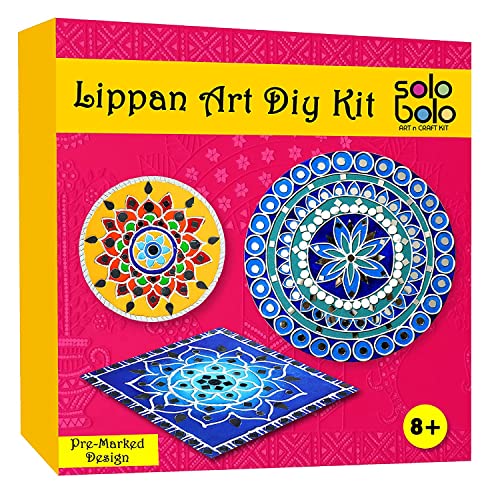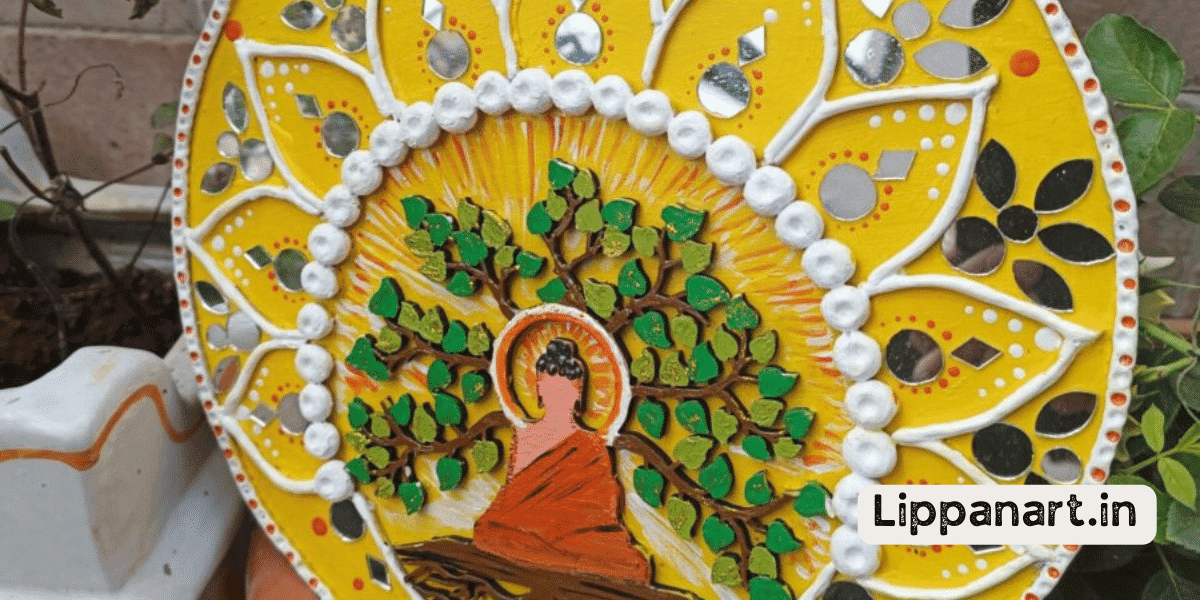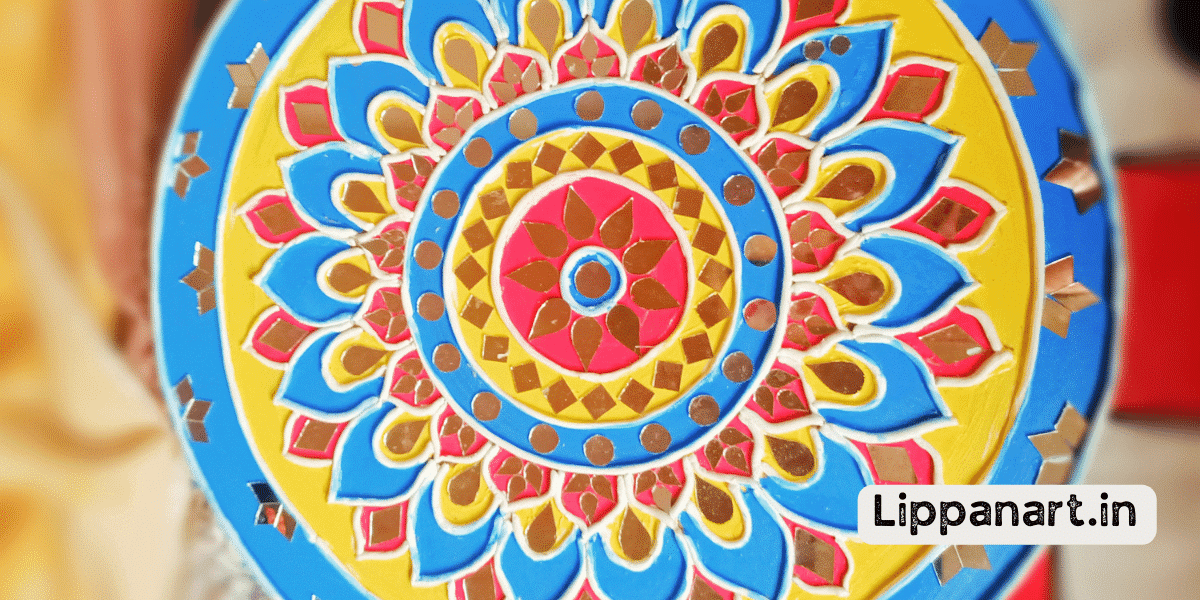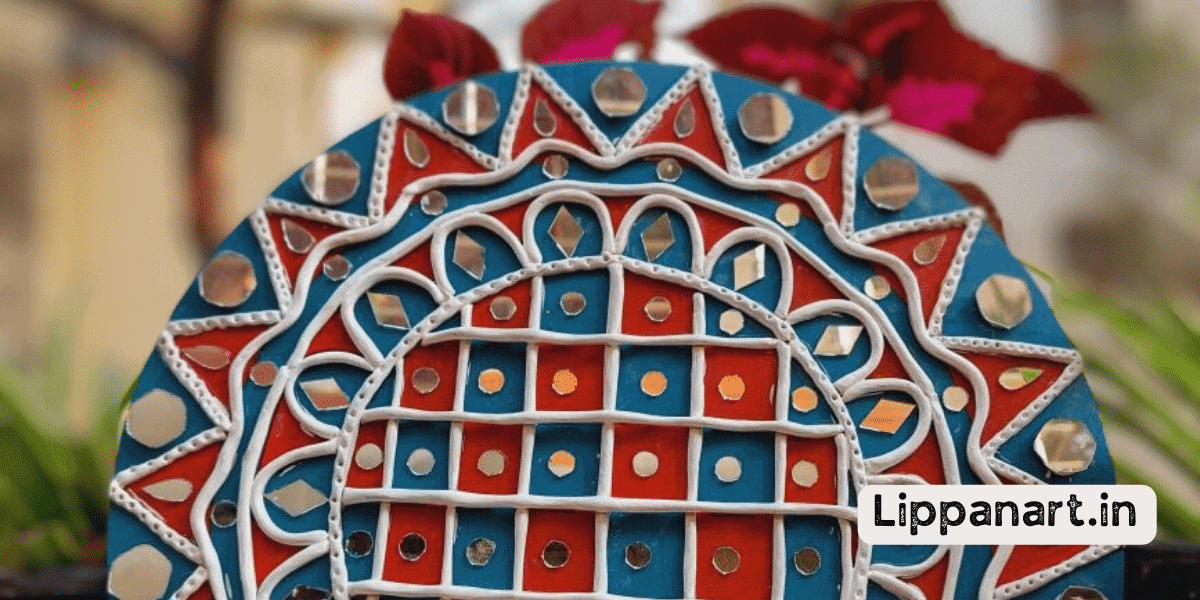You may think that lippan art is a thing of the past, but this ancient art form is alive and well!
With a deep knowledge of its history and an analytical approach to the differences between traditional and modern lippan art, you can journey through the centuries and explore the evolution of this creative medium.
By understanding the techniques, themes, and materials used in traditional and modern lippan art, you can appreciate the passion this art form evokes and the importance of preserving it for future generations.
History of Traditional Lippan Art
Traditionally, lippan art dates back centuries and has been an integral part of Indian culture. Lippan is an art form that is practised in villages across the country. It involves using clay and other materials to create intricate motifs and patterns. These motifs are mostly inspired by nature and are often used to decorate the walls and ceilings of homes.
The art form has been passed down from generation to generation, with the same motifs and patterns used in the same way. This has helped to preserve the art form and keep it alive for centuries. Although there are some differences between traditional and modern lippan art, the core elements remain the same.
Traditional lippan art is characterized by its use of clay and intricate motifs and patterns, often inspired by nature. It also emphasizes the importance of preserving the art form and passing it down from generation to generation.
Materials Used in Traditional Lippan Art
You typically use natural materials such as mud, clay, charcoal, and vegetable dyes to create traditional lippan art. These materials have been used to craft this art form for centuries and are still used today to adorn walls and create intricate patterns. Traditionally, walls were covered in these geometric patterns, made with vegetable dyes and mud or clay. The craft of lippan art is also known for its use of charcoal, which often provides a darker background for the patterns.
| Material | Use |
|---|---|
| Mud | Used to craft geometric patterns |
| Clay | Used to craft geometric patterns |
| Charcoal | Used to provide a dark background |
| Vegetable Dyes | Used to colour patterns |
Traditional Lippan Art Techniques
To create intricate patterns of lippan art, you’ll need to master certain techniques.
Lippan kaam is an ancient traditional art form of clay, mirrors, and other materials. It is a collection of traditional motifs handed down through generations.
To create lippan art, you’ll need to first prepare the clay. This includes mixing it with water and other ingredients to create a malleable mixture. Then, you must mould the clay into the desired shapes and patterns.
- Editor’s Choice
- Best Seller
- Amazon Choice
Themes of Traditional Lippan Art
Themes of traditional lippan art often depict nature and scenes of everyday life, such as farming, fishing, and feasting. These themes were mostly created using camel dung as a medium to make intricate paintings and murals. Along with nature and everyday life, traditional lippan art often featured animals in symbolic form. These animals were often representations of gods and goddesses and were used to illustrate stories of mythology and folklore. They also served as a reminder of the importance of animals in daily life, such as their use for transportation and labour. Traditional lippan art could also feature non-animal forms, such as geometric shapes and floral designs.
These traditional lippan art themes were very different from modern art in that they were often symbolic and used to portray stories or events. However, the modern lippan art form is often abstract and only sometimes has a clear narrative. Despite these differences, traditional and modern lippan art forms are similar in that they often have a vibrant colour palette and intricate details.
Overall, traditional lippan art themes have been preserved over the centuries and are still used today to communicate stories and evoke emotion. By studying the similarities and differences between traditional and modern lippan art, we can better understand this unique art form and its importance in Indian culture.
Introduction of Modern Lippan Art
With its vibrant colours and intricate patterns, modern lippan art has become increasingly popular in recent years. Modern lippan art is a form of Indian art originating in the Kutch region of Gujarat. This type of art is created with acrylic paints and often uses everyday tools, such as sticks and kitchen utensils, to create delicate patterns. The themes within modern lippan art reflect the values and beliefs of the communities that produce it, often representing elements of everyday life.
The table below shows the similarities and differences between traditional and modern lippan art.
| Traditional Lippan Art | Modern Lippan Art |
|---|---|
| Region: Kutch, Gujarat | Region: Kutch, Gujarat |
| Tools: Natural, such as sticks and kitchen utensils | Tools: Acrylic paints and everyday tools |
| Themes: Religious and spiritual symbols | Themes: Values and beliefs of the community |
Modern lippan art stands out from traditional styles with its vivid colours and intricate designs, allowing it to become a popular art form across many regions. This type of art still celebrates the values and beliefs of its communities while offering a more modern take on traditional themes. As such, modern lippan art has become an important way to preserve the culture and history of the region.
Materials Used in Modern Lippan Art
You may be surprised that modern lippan art is created with more than acrylic paints! While traditional lippan art was made with camel dung and water, modern lippan art uses various materials.
One of the most popular materials used in modern lippan art is Shilpkar clay, an air-drying clay that is easy to work with and provides a variety of textures and colours. Furthermore, contemporary lippan art frequently uses acrylic paint to enhance the artwork with vivid and lively colours.
Modern lippan art gives artists more creative freedom than traditional lippan art and allows for more intricate and detailed artwork. However, traditional lippan art remains popular amongst those who appreciate its rich history and want to preserve it.
- Editor’s Choice
- Best Seller
- Amazon Choice
Modern Lippan Art Techniques
Creating modern lippan art requires a variety of techniques, from the use of air-drying clay to intricate painting. The art form can involve a range of craft supplies, from glue and paint to beads and glitter. To capture the beauty of contemporary lippan, artisans often use Instagram and other social media platforms to share their scintillating murals.
Modern lippan art is distinct from traditional lippan art in that it focuses on using modern materials that help create unique and eye-catching wall art. Artisans often use bright colours and various materials to create visually appealing and intricate pieces.
The techniques used to create modern lippan art are similar to those used in traditional lippan art. However, modern methods often involve more intricate and creative effects. Artisans often use a combination of glueing, painting, and other methods to create beautiful works of art. Additionally, modern lippan art may involve using modern materials such as glitter and beads to add texture and dimension to work.
With a thorough knowledge of the history of lippan art, an analytical approach to studying the similarities and differences between traditional and modern lippan art, and a passion for studying and preserving the art form, contemporary lippan art can be a beautiful addition to any home or office.
Themes of Modern Lippan Art
Exploring modern lippan art reveals a range of inspiring themes, from abstract designs to vibrant pop art. Modern lippan art expresses the contemporary Muslim community’s culture, beliefs, and values. The art form is used to decorate outer walls, trees, and other exterior surfaces with colourful, intricate patterns made of white clay. The community believes that it brings good luck and prosperity.
Traditional lippan art focuses more on religious and spiritual themes, while modern lippan art often draws inspiration from pop culture and modern art. The themes of modern lippan art reflect the changing times while maintaining the traditional aesthetic. By combining traditional and modern elements, modern lippan artists can create unique and beautiful artworks that honour the past and look to the future.
Whether the designs are abstract or representational, the outer walls of a home or a business can be transformed into a beautiful, vibrant work of art.
Differences Between Traditional and Modern Lippan Art
Comparing the two, you can see the distinct differences between older and newer styles of artwork. Traditional lippan art originates from the pastoral communities of Kutch, a desert region in North-West India. This art form uses crushed seashells, ice cream sticks, and other natural materials to create bright and intricate patterns on walls and other surfaces. Modern lippan art, on the other hand, has evolved to incorporate more abstract elements, such as the use of colour and texture to express emotion.
| Traditional Lippan Art | Modern Lippan Art |
|---|---|
| Material-based | Abstract |
| Intricate Patterns | Colour and Texture |
| Kutch Lippan | Mural Tradition |
Traditional lippan art is a centuries-old practice rooted in the Kutch lippan tradition. Modern lippan art, however, is a more recent development and has been shaped by the mural tradition of India. It is a more expressive and experimental form of art that explores the use of colour and texture creatively. The two styles are fundamentally different yet have much in common, such as using natural materials and the desire to create vibrant artwork.
The popularity of Lippan Art Today
You’re likely to see lippan art pop up in many places today, from home decor to street art. This intricate art form has been around for centuries and remains popular due to its modest stature and detailed craftsmanship. It is an artisanal and craft form and a beloved part of Indian culture.
The popularity of lippan art today is due to its ability to capture the past and the present. The traditional clay art form is filled with intricate patterns and designs, often telling a story of Indian culture. Meanwhile, modern lippan art incorporates new and unique designs and patterns, creating something familiar and new.
Modern lippan art is an exciting way to express creativity and honour the past. It is a way to bring two different worlds together and create something unique and meaningful.
Here are four ways lippan art captures the imagination today:
- Intricate patterns and designs
- Modest stature and craftsmanship
- Clay is an art form that tells a story
- An artisanal craft form that is beloved in India
Frequently Asked Questions
What are the environmental impacts of creating traditional and modern Lippan art?
Creating lippan art has an environmental impact – traditional and modern styles both require resources. Analyze their similarities and differences to study and preserve the art form.
Are there any health and safety considerations when creating Lippan art?
When creating lippan art, safety is key. Wear gloves, use a dust mask, and keep your workspace clean. Avoid solvents and heat, which can cause burns and/or toxicity. Take precautions to prevent injury and preserve the art form.
How is traditional Lippan art different from other types of folk art?
Have you ever wondered how traditional lippan art differs from other folk art forms? It is unique in its intricate patterns and use of natural materials. Its history and techniques are deeply rooted in Indian culture, making it a highly respected art form. Analyzing the similarities and differences between traditional and modern lippan art reveals its evolution and beauty.
Are there any special tools or techniques used to create Lippan art?
Tools and techniques used in lippan art vary, depending on the type of art you’re making. Traditional lippan art typically uses materials like glass, mirrors, and clay, relying on intricate patterns and exacting precision. Modern lippan art often utilizes modern materials and technologies like digital art but still draws on traditional techniques.
What is the best way to store and display Lippan art?
Storing lippan art requires careful consideration. Protect from direct sunlight, dust and moisture. Display in low-humidity environments and use archival-quality materials for mounting and framing.
















